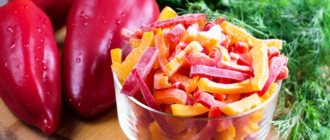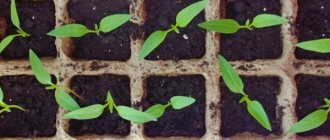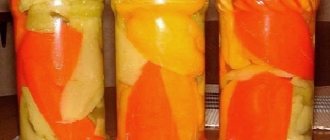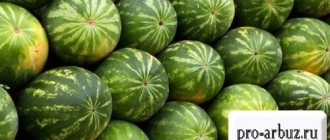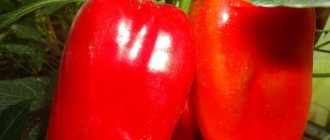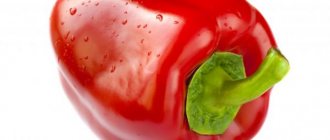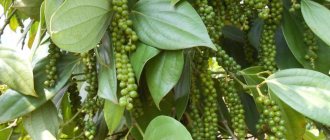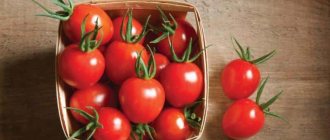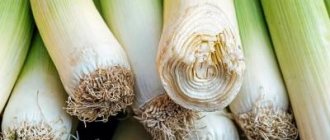When to Harvest
In order for the vegetable to be stored longer, it must be collected on time. When ripening, peppers go through several stages. This time is called removable biological maturity. During this period, the fruits are saturated with mineral elements, which make them especially valuable.
- Technical maturity - vegetables grow to their maximum size, acquire taste and juiciness, but do not yet reach the varietal indicator in color.
- Biological maturity - the pepper is fully ripe, filled with smell, sweet taste, becomes rich in color (red, yellow, orange, etc.) depending on the variety, it can be easily removed from the bush.
During the period when the vegetables are still “green”, they are harvested every week. Pepper can be stored in this state for a long time if it is properly prepared and optimal conditions are created.
After reaching biological maturity, pepper quickly deteriorates. It should be eaten as early as possible or used to prepare all kinds of dishes.
We recommend reading: Storing hot peppers in winter in fresh, dried and canned form
The best varieties of peppers for storage
Long-lasting and transportable fruits that belong to mid-ripe and late-ripening varieties.
It belongs:
- To “Beglitsky”, high-yielding large-sized vegetables, with dark red shades.
- “Swallow”, the most common variety with a high yield. Cylindrical shapes, lettuce for a technical degree, red for a biological one, specimens.
- “Novogogosharam”, medium early, with round-flattened red peppers. They have increased shelf life and transportability.
- “Red Baron”, bright lilac fruit, technically ripened and dark red, biological.
- “Black cardinals”, late vegetables, red for the biological type in terms of maturity, and dark purple for the technical type.
- “Aristotle”, a hybrid large-cylindrical pepper, at first dark green, then rich red, tasty and beautiful.
How to choose vegetables at the market
You can save peppers for the winter not only if you grow them yourself, but also if you bring them from the market. After all, not everyone has the opportunity to grow it on their plot.
When purchasing, pay attention to the appearance of the vegetable:
- the skin should not have any damage: stains, dents, cracks;
- a wet tip indicates the process of rotting inside.
A glossy surface and an even color tone indicate a quality product.
The birthplace of bell pepper is not Bulgaria at all, but America. And the vegetable acquired its name thanks to Bulgarian breeders who developed its sweet variety
Errors
Failures with pepper harvesting are rare, but they do happen. The most important mistake of novice housewives is improper preparation of fruits - washing them, after which the vegetables immediately spoil. Storing rotting fruits together with healthy ones is unacceptable; in a matter of days, the entire crop becomes covered with rot and can be thrown away.
Another common mistake is removing the stem from the fruit and storing it indoors. The stalk performs a protective function; in its absence, the pepper begins to dry out.
Otherwise, preserving peppers until winter is not so difficult, the main thing is to be careful, and such troubles will not happen.
Preparation for fresh storage
Before deciding how to store bell peppers at home, you need to carefully prepare them:
- Peppers should have a tail; they are cut from the bushes, not picked.
- Do not wash the vegetables, just wipe off the dirt with a damp cloth.
- Identify low-quality specimens: spread out the fruits and leave them for a week, then discard the spoiled ones.
- Cut off the stem, leaving a small shoot.
Tip of the day
Do not store fruits that show signs of wilting.
Product preparation and selection
Peppers on the bushes take a long time to ripen. Once the fruit reaches full size, it will take another 30-40 days to develop its final color. A mature vegetable can be yellow, red, or brown. For storage, it is better to use unripe fruits, since they are stored much longer than ripe ones.
Important!
Ripe peppers contain more vitamins and nutrients than unripe peppers.
The following requirements apply to vegetables:
- The fruit must be healthy, there should be no dents or rot on the skin.
- The skin should be hard.
- The pod must have a stalk, which is treated with a 2% solution of copper sulfate or a pink solution of potassium permanganate before storage.
When the fruits are selected, they are wiped with a dry towel and stored. It is strictly forbidden to wash the pepper, much less store it in a wet state. The harvest will definitely be ruined, as the fruits will instantly become covered with mold and will soon begin to rot.
Storage conditions
Anyone who wants to enjoy the taste and aroma of this miracle of nature can keep peppers fresh for the winter.
We also recommend reading:
Harvesting, harvesting and storing parsley root Cabbage: how to harvest and store fresh. Preservation, drying, freezing Kohlrabi: how to store “northern lemon” at home Garlic for the winter: how to collect, prepare and store the harvest at home
Optimal conditions for saving vegetables:
- temperature from 0 to 11 °C;
- air humidity 90-95%;
- good room ventilation.
Residents of high-rise buildings can use a glazed balcony and a cool storage room. And in a private house there is always a cellar, a basement, or, in extreme cases, a glassed-in veranda.
Do you know that…
When the temperature increases or decreases relative to the optimal one, the storage time of the sweet vegetable decreases.
Rules for storing peppers in the refrigerator in the vegetable compartments
You will use the peppers for 3 months if you store ripe peppers. Unripe ones will simply spoil.
To make this bookmark, vegetables:
- Rinse;
- Dry;
- Rub with sunflower oil (you can use any other vegetable oil). The oil will give them a firm and fresh appearance.
- Then, as in the case of storing on a balcony, wrap each pepper in paper or polyethylene and make ventilation holes in the polyethylene.
How to keep vegetables fresh
Bell peppers are stored in wooden or plastic boxes. The container is washed and dried in advance. It’s good if wooden containers are made from slats. If not, then holes are made in them.
- For “green” peppers, the boxes are first lined with paper, and the vegetables are laid out so that they do not come into contact with each other. Cover with paper or cloth. A few more layers are placed on top, but so as not to press down the lower ones.
- For ripe fruits, you can sprinkle layers of peppers with clean and dry river sand, perlite or vermiculite (see “5 reasons to use perlite and vermiculite for winter storage of vegetables, fruits, rhizomes, tubers and bulbs”), as well as wood shavings. The sand is calcined for reliability, and the shavings are taken from fruit trees.
- For ripening , a method of preserving sweet peppers is to wrap each fruit in paper. It requires additional time, and to check the status of inventory, you will have to unroll each copy.
- In the refrigerator, you can keep sweet vegetables fresh in plastic bags if they have holes for ventilation. Special perforated bags have the best effect. Food grade film is also suitable. By wrapping each pepper separately, you can avoid condensation, which causes rot.
Peppers vary not only in color, but also in the content of nutrients. So, red contains a lot of lycopene and carotene, yellow contains potassium and phosphorus, and green contains phytosterols that remove cholesterol.
To keep peppers fresh for the winter, another interesting technique is used:
- During the period of technical maturity, the bush is dug up without damaging the roots.
- Planted in a large flower pot.
- Place on the balcony for gradual maturation.
Do you know that…
Pepper is a perennial plant. Having given away the harvest, it can easily survive until spring, and with increasing daylight hours, begin a new stage of flowering and fruiting.
In the cellar
The cellar is the most suitable place to store bell peppers fresh in winter. Here they do not just store unripe vegetables, but bring them to a ripe state. This process takes place under certain conditions:
- temperature close to 10 °C;
- humidity 95%;
- lack of lighting.
During harvest, it is still warm outside, so it is possible to create such conditions.
Selected and prepared vegetables are placed in boxes in layers, which are lined with paper. When each fruit is wrapped in paper, they take longer to ripen, but their shelf life also increases.
Ripening will take place within 1.5-2 months. During this time, the air temperature will drop and become comfortable for storing ripe peppers (0-2 °C). In total, vegetables can stay in the cellar for up to six months.
Do you know that…
You can store vegetables in the cellar without removing them from the bush. They dig it up, shake off the remaining soil and hang it upside down. But it should be remembered that with such storage, spoilage of 60% of the fruit is the norm.
In the apartment
Now we’ll figure out how to store bell peppers in an apartment so that they turn from green to red and don’t spoil.
To ripen, vegetables are placed in a cool and dark pantry. A balcony or loggia is also suitable. Compliance with the conditions is regulated using the window: do not close it when it is up to 10 ° C outside, and vice versa. The boxes with fruits are covered with something to prevent sunlight from penetrating.
You can use any container, as long as air penetrates into it. Vegetables can be stored this way for about 2 months.
Do you know that…
The method of storing peppers on a dug-out bush is also suitable for a balcony in a city apartment. In this case, sunlight will not harm - the fruits will only grow.
In a refrigerator
It is best to store sweet peppers at home where the temperature is constant. To save small amounts, use a refrigerator.
Vegetables are placed in the lower compartment. The previously described techniques are used: each fruit is wrapped in paper and placed in a plastic bag with holes.
Sweet peppers can be made into a dried seasoning. To do this, the vegetable must be finely chopped, dried in a convenient way, and then ground into powder.
How to store at home: terms and conditions
If the product is prepared correctly, then there are no difficulties during storage. The harvested crop is stored for a long time under cool conditions - up to 100-120 days. At room temperature, the shelf life of unripe fruits is 2 months. If the pepper is already red, then it will not last long in the apartment - the maximum shelf life is 2 weeks. Frozen and canned vegetables are stored for a long time - from 1 year or more.
Tara
To prepare fresh peppers, clean, dry containers made of durable material should be used. Can be used:
- plastic food containers;
- wooden boxes;
- carton boxes;
- glass jars;
- plastic bags;
- cling film;
- foil.
It is not recommended to store vegetables for a long time in metal containers made of aluminum.
Influence of humidity, temperature and lighting
The following factors influence the shelf life:
- Temperature. The optimal temperature at which the vegetable will be stored for the longest possible time is from plus 5 to 18 degrees Celsius. At lower temperatures, the fruits will freeze and change in taste. At high temperatures, shelf life decreases with each added degree.
- Humidity. Too much humidity will cause rot on the fruit, while too little moisture will cause the vegetables to dry out. Humidity should be between 20 and 50% in the storage area.
- Lighting. Sunlight helps accelerate the coloring of fruits. If you place unripe green peppers on the windowsill, they will reach maturity in 2-3 weeks. If the main goal is to keep the pepper fresh for as long as possible, exposure to sunlight is not permissible.
For storage, they often choose a cool place with low light and average humidity - a basement, refrigerator, cellar, balcony, loggia, pantry.
Two types of freezing
One way to preserve aromatic and healthy vegetables with minimal losses is to freeze peppers for the winter.
In the form of slicing
In this case, you can use fruits with dents, cracks or spoiled:
- Wash the peppers, dry them, remove the seeds and stems.
- Cut into strips or cubes depending on how they will be used.
- Place the slices in plastic bags, squeeze out excess air to prevent ice from freezing, and place them in the freezer.
You can also use plastic containers for freezing.
Such preparations are indispensable when preparing vegetable dishes, casseroles, salads, and baking pizza. Frozen fresh bell peppers will allow you to diversify your menu and replenish the body with essential substances during the cold season.
Tip of the day
2 hours after placing in the freezer, the bags with pieces of vegetables need to be shaken so that the individual pieces peel off from each other. You will get a crumbly freeze.
Whole for stuffing
You can freeze bell peppers whole for the winter. This makes it possible to pamper your loved ones with stuffed vegetables almost all year round.
- Select whole medium-sized specimens.
- Remove the core without disturbing the integrity of the fruit, shake out the seeds.
- Cut small squares of cellophane.
- Wrap the sharp end of the peppers in cellophane and insert them into each other in any quantity.
- Place in packaging and then in the freezer.
This method avoids the peppers freezing to each other and saves space in the freezer.
Note to the hostess
Some housewives, in order to save their time, freeze vegetables already filled with minced meat.
Preparation of semi-finished products
You can use semi-finished vegetables all winter for any dishes. Some housewives prefer to make preparations using various vegetables. Such semi-finished products are very convenient and useful to use. In winter, you can simply take out the prepared mixture and prepare a fragrant, healthy dish.
Such semi-finished products include: vegetable mixtures, stuffed peppers, canning.
Vegetable mix
The mixture can be used in vegetable stews, soups, main courses, and in cooking meat and fish. For cooking, you can choose any vegetables that match the taste of sweet pepper.
Suitable for vegetable mixture:
- carrot;
- green beans;
- green pea;
- onion;
- corn;
- broccoli.
Preparing the mixture is very simple. All vegetables must be washed under running water, dried well on a towel, and cut. Mix the mixture and place it in plastic bags or special containers, not forgetting to release the air.
Stuffed pepper
A wonderful nutritious dish is stuffed peppers. You can enjoy this dish all winter long if you prepare it in advance. You need to decide how to freeze peppers for stuffing for the winter, and you can choose the filling to your taste.
Stuffed pepper filling:
- vegetable filling with rice;
- minced meat with or without rice;
- minced meat with added mushrooms;
- minced shrimp or squid.
Each filling is unique. Therefore, the taste of the dish depends on the imagination of the hostess. In order to prepare this dish, you need to prepare the fruits and minced meat.
Preparing stuffed peppers:
- Prepare minced meat with any filling. The main thing is that the minced meat is not too liquid.
- Each fruit must be carefully cut off the stem and remove the seeds.
- Wash the fruits and dry.
- Fill each vegetable with minced meat and place in the freezer separately. This is done in order to maintain the shape of the fruit.
- After about a day, you can put the finished semi-finished products into bags or containers.
In this form, the vegetable can be stored for a year.
Preservation recipes
You can preserve sweet peppers for the winter without freezing - using canning. Housewives use their skills and create more and more new homemade recipes.
A purple variety, rare in Russia, has this color thanks to anthocyanins - substances that protect the plant from frost, and in humans increase immunity and visual acuity
Seasoning with salt
You can preserve bell peppers as a seasoning for various dishes: sauces, baby food, vegetable purees and cocktails.
Ingredients:
- 1 kg red pepper;
- 1 tbsp. l. salt without top.
Cooking process:
- Twist the peeled and chopped peppers through a meat grinder.
- Add salt, stir and leave for 10 minutes. brew.
- Fill the prepared jars with the mixture.
- Top each jar with 2 tbsp. l. vegetable oil to prevent mold from appearing.
- Close with a nylon lid. Store in the refrigerator.
Features for the variety "Ogonyok"
Pepper variety Ogonyok
Pepper “Ogonyok” is a bitter perennial.
It can grow in an apartment (house) as an ornamental plant, from which an aromatic seasoning is obtained. The fruits are small, in the form of pods. In Western countries, Ogonyok is grown only for decorative purposes; in our country, a spicy seasoning is prepared from this plant. How to preserve hot pepper Ogonyok for the winter?
Methods for storing hot pepper "Ogonyok":
- Drying. Dried fruits are stored in a box, and also hung in a pantry or other cool room from the ceiling (by the stalks). Before drying, it is not necessary to pick the fruits; they can be stored along with the bush.
- Grinding dried pods. The seasoning prepared in this way is placed in bags (made of polyethylene or paper) or in glass jars.
- In oil.
Freshly picked pods are separated from the stalks and placed in jars, having previously sterilized them. Heated sunflower or rapeseed oil is poured into the container. The jars are rolled up with lids. This storage method is expensive in terms of oil, but it is preferable to others because it improves the taste of the fruit.
Drying in oil
Drying bell peppers is another way to preserve the vegetable for a long time with the maximum possible amount of nutrients, vitamins and minerals.
For drying, it is necessary to select whole, undamaged fruits, not overripe and without signs of rotting. For this storage method, use thick-walled types of vegetables.
Wash the selected fruits, dry them and cut them into halves; large ones - into quarters. If you have time, take the time to remove the skin from them, this will give you a richer taste and aroma of bell peppers. To easily peel the skin, immerse the prepared fruits in boiling water for 2 minutes, then transfer to cold water for the same time. Remove the pieces from the water and remove the skin by carefully prying it off with a knife.
After this, grease each piece with oil. You can use either sunflower or olive oil, according to your taste. To enhance the taste and aroma, it is recommended to use mixtures of dried herbs; it would also be a good idea to sprinkle the preparations with salt and black or red ground pepper.
Now begin the drying process. How best to do this, choose based on your capabilities. Dried peppers are equally delicious in both a gas oven and an electric oven. An electric dryer is also suitable for this process.
Place the workpiece on a baking sheet or wire rack in the oven at a temperature of 70-80 ° C for 1.5-3 hours. After this time, increase the temperature to 100 °C and continue drying the workpiece. In this mode, leave the pepper in the oven for another 30-40 minutes. After this, the workpiece should “rest”. Remove it for 20-30 minutes and return it to drying in the oven at 100°C for 40 minutes.
Attention! It is easy to determine the readiness of the product: the pulp of the dried pepper in the oil will become one third less than at the initial stage, and the slices themselves will darken.
This preparation is stored in jars with oil. To do this, prepare clean, sterilized jars and layer dried peppers, pieces of garlic and vegetable oil to the very top. Also add rosemary, thyme and basil for flavor and aroma. Place the peppers tightly so that no air remains in the jars. Now the preparation is ready, store it in the refrigerator, and in winter add it to salads or eat it as an independent dish.
Tips and secrets
There are a few more tips that will help keep the product fresh, tasty and healthy for a long time:
- Do not use unripe peppers for refrigeration. At cold temperatures it will not ripen and will begin to deteriorate.
- Sweet peppers of different degrees of ripeness should not be stored together, as this will speed up the ripening process of the unripe product, which will lead to further spoilage.
- Products stored in the basement or refrigerator are periodically checked for freshness. If a spoiled one appears in a common container, remove it immediately.
